Polyacrylamide Market Size
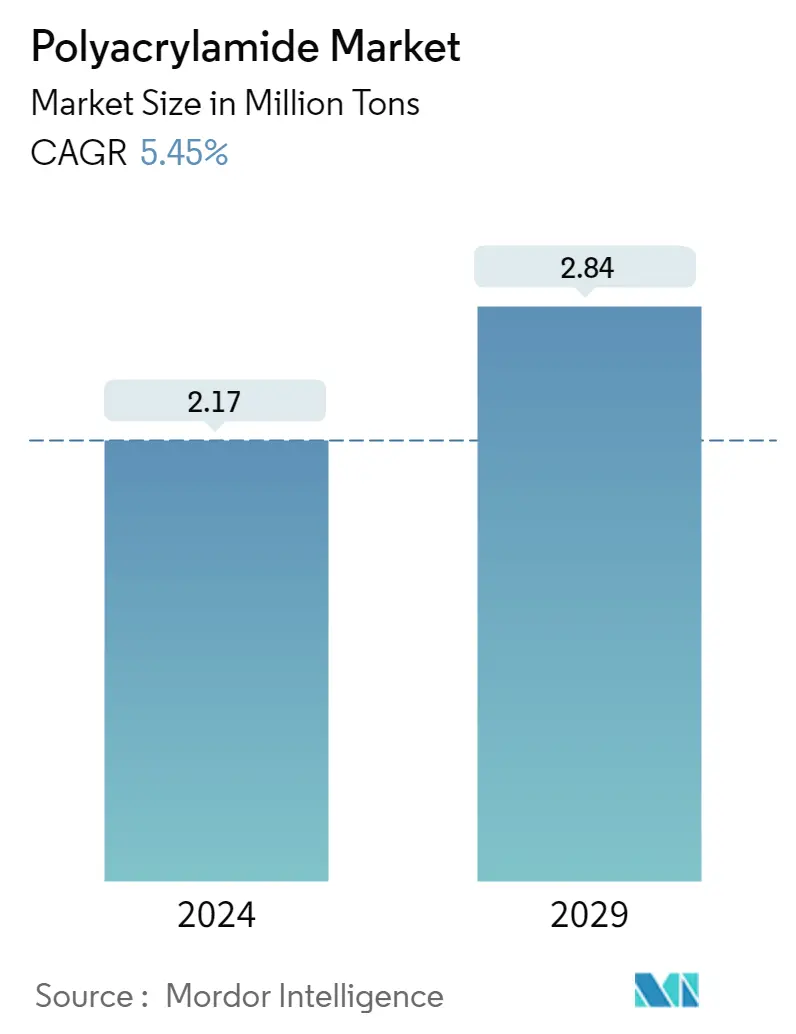
| Study Period | 2019 - 2029 |
| Base Year For Estimation | 2023 |
| CAGR (2024 - 2029) | 5.45 % |
| Fastest Growing Market | Asia Pacific |
| Largest Market | Asia Pacific |
| Market Concentration | High |
Major Players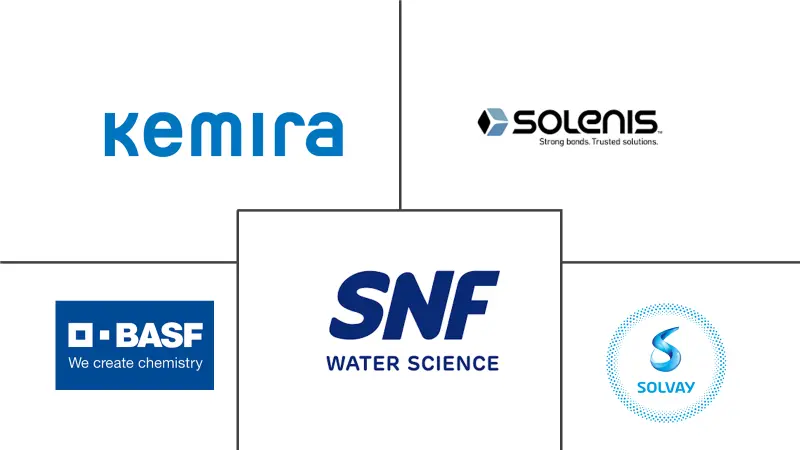
*Disclaimer: Major Players sorted in no particular order |
Polyacrylamide Market Analysis
The Polyacrylamide Market size is estimated at 2.17 Million tons in 2024, and is expected to reach 2.84 Million tons by 2029, growing at a CAGR of 5.45% during the forecast period (2024-2029).
In 2022, the COVID-19 pandemic, on a global scale, forced water treatment, pulp and paper, oil and gas, and mining industries to shut down their operations, lowering the demand for polyacrylamide. The pandemic impacted almost every aspect of these industries, from product demand to workforce development to accelerating or decelerating trends already underway when it struck. Customers and their temporary production stops reduced production levels, and demand reductions significantly impacted production processes. However, the condition is expected to recover, restoring the growth trajectory of the market during the latter half of the forecast period.
- In the medium term, the growing utilization in the oil and gas industry for enhanced oil recovery and the increasing need for polyacrylamide as a flocculant in the water treatment industry are expected to drive demand.
- Health concerns caused by exposure to acrylamide monomer is expected to hinder the market's growth.
- The emerging application of polyacrylamide in the biomedical industry and the development of bio-based polyacrylamide are expected to offer lucrative opportunities to the market.
- Asia-Pacific accounted for the highest market share, and the region will likely dominate the market during the forecast period.
Polyacrylamide Market Trends
Water Treatment Industry to Dominate the Market
- Polyacrylamide is a kind of polymer flocculant that is soluble in water and is produced using acrylamide polymerization. The polymer is deemed ideal for water and wastewater treatment because of its ability to increase viscosity and promote the flocculation of particles. Therefore, this polymer, as a flocculant, can be used for the purification of industrial water, drainage purification, sewage treatment, and wastewater treatment.
- It can also be utilized in the drinking water industry as well, where the presence of sodium in raw water due to colloidal particles makes it unfit for drinking, thereby needing to be dissolved and filtered before usage. Polyacrylamide, in this case, acts as a low molecular weight flocculant and removes the additional sodium from water, making it suitable for drinking purposes.
- The use of polyacrylamide in the water and wastewater industry minimizes the usage of other conventional flocculants for the removal of bacteria, viruses, algae, and other unwanted impurities, resulting in significantly less sludge and making the process more economical and cost-effective.
- The global water consumption rate is increasing by 100% every twenty years. The rising scarcity of potable water, coupled with the growing population and increasing water demand, is the major concern that is driving the demand for the membrane wastewater treatment market across the world. Currently, China and the United States represent the two largest water reclamation and reuse markets across the world.
- In June 2022, an environmental protection company that focuses on water environment management, named China Everbright Water, secured the expansion and upgrading project of the Zhangdian East Chemical Industry Park Industrial Wastewater Treatment in Zibo City, Shandong Province. This project will be operated on a BOT (Build-Operate-Transfer) model, with a designed daily industrial wastewater treatment capacity of around 5,000 m3.
- The United States Environmental Protection Agency (EPA) announced an investment of USD 7.5 billion in September 2023 in available Water Infrastructure Finance and Innovation Act (WIFIA) funding. This innovative low-interest loan program helps communities invest in drinking water, wastewater, and stormwater infrastructure while saving millions of dollars and creating good-paying local jobs. To date, EPA’s WIFIA program has announced USD 19 billion to help finance 109 projects across the country.
- The German water treatment technology market is the largest in Europe and is growing considerably. The increasing water treatment activities, primarily in the country's Northern region, are boosting the demand for water treatment chemicals. The country’s water supply and wastewater treatment sectors account for about EUR 22 billion (USD 23.33 billion) annually, as per the Federal Ministry for the Environment and Nature Conservation.
- According to the Eurostat and Statistisches Bundesamt, the revenue of Germany's water supply, sewerage, and waste management industry generated USD 99.63 billion in 2022.
- Considering the growth trends and various water treatment projects in different regions worldwide, the water treatment industry is likely to dominate the market, which, in turn, is expected to enhance the demand for polyacrylamide during the forecast period.
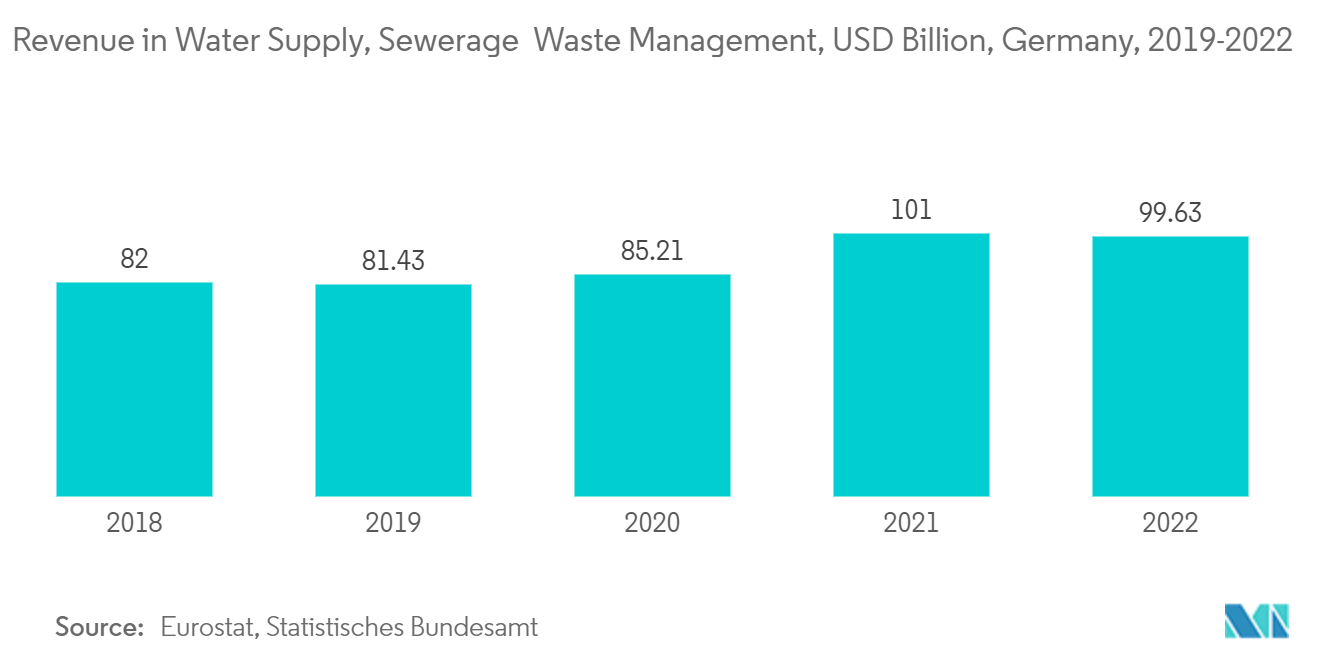
Asia-Pacific to Dominate the Market
- The Asia-Pacific region dominated the polyacrylamide market in 2022 with a considerable volume share, and it is expected to maintain its dominance during the forecast period.
- In recent years, China has increased the use of treated water to reduce its dependency on fresh water. With a tough regulatory framework and the increasing importance of water reuse in China’s five-year plans (FYPs), the country is rapidly moving toward enhancing its water treatment industry for a sustainable future.
- Suez Group bagged a new contract for a water treatment project in China in September 2023 to contribute to the country's 2060 carbon neutrality ambition. The company, in collaboration with Chongqing Water Group (CWG), is investing around USD 168 million for the construction and operation of a water treatment plant in Chongqing, China.
- In the oil and gas industry, The Tarim Oilfield, controlled by China National Petroleum Corporation (CNPC), China's largest oil and gas producer, saw its annual oil and gas production reach a record high of 33.1 million tons in 2022. The oilfield is estimated to have generated 7.36 million tons of crude oil and 32.3 billion cubic meters of natural gas in 2022.
- In India, in July 2023, IDE Technologies received a contract from CleanEdge Water Pte Ltd for the construction of a state-of-the-art wastewater treatment plant (WWTP) for mining industry applications. This project is expected to be supplied to the company by IDE Technologies in 2024 and is estimated to treat 4.0 million liters of challenging brine per day.
- The paper demand in India is expected to reach 23.5 metric tons per year by 2025. Some paper mills have existed for several decades, making upgrades and investments into newer machinery necessary. The per capita paper consumption in India, at a little over 13 kg, is way behind the global average of 57 kg. The market for paper and paper products in India is estimated to reach USD 13.4 billion by 2024.
- In the mining industry, state-run Coal India Ltd (CIL) has approved 32 mining projects till January 2022, with an investment of around INR 47,300 crore as the company seeks to replace imports and move toward its 1 billion tons of coal production target by 2023-2034.
- Factors like these are likely to fuel the growth of the polyacrylamide market in Asia-Pacific over the forecast period.
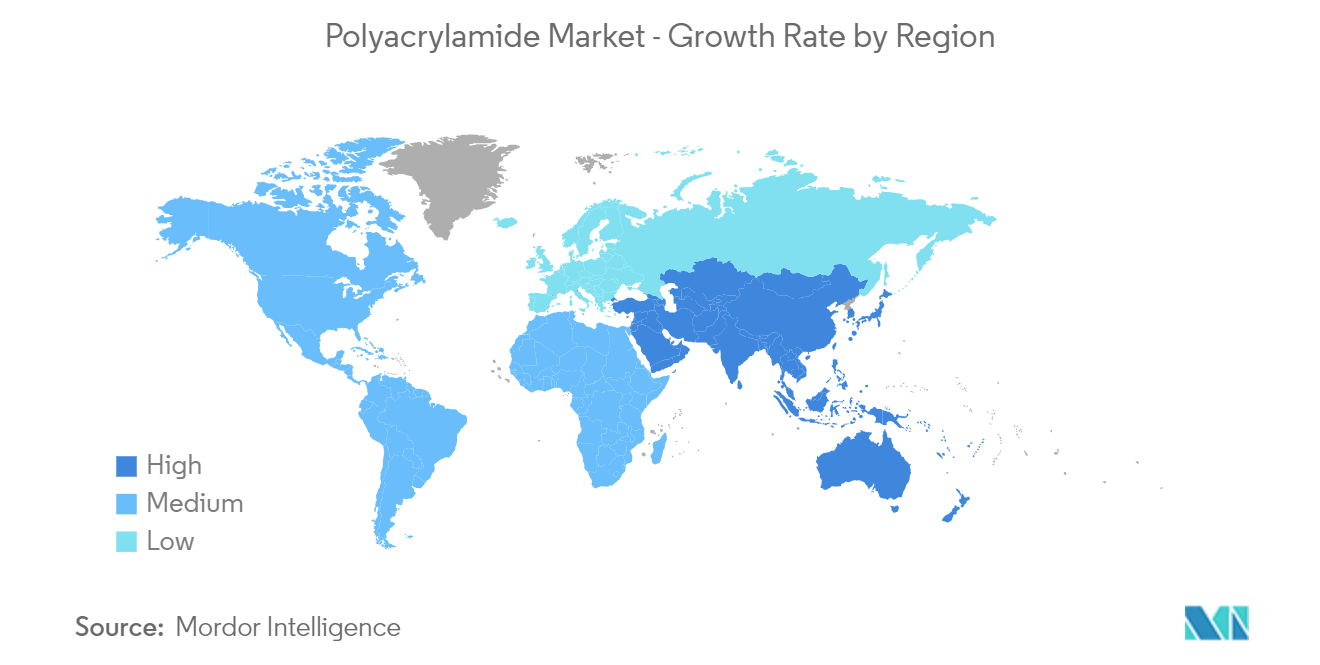
Polyacrylamide Industry Overview
The polyacrylamide market is highly consolidated, with the major players accounting for a major market share. Some of the major players in the market (not in any particular order) include SNF Group, BASF SE, Kemira, Solenis, and Solvay, among others.
Polyacrylamide Market Leaders
-
SNF Group
-
Kemira
-
BASF SE
-
Solenis
-
Solvay
*Disclaimer: Major Players sorted in no particular order
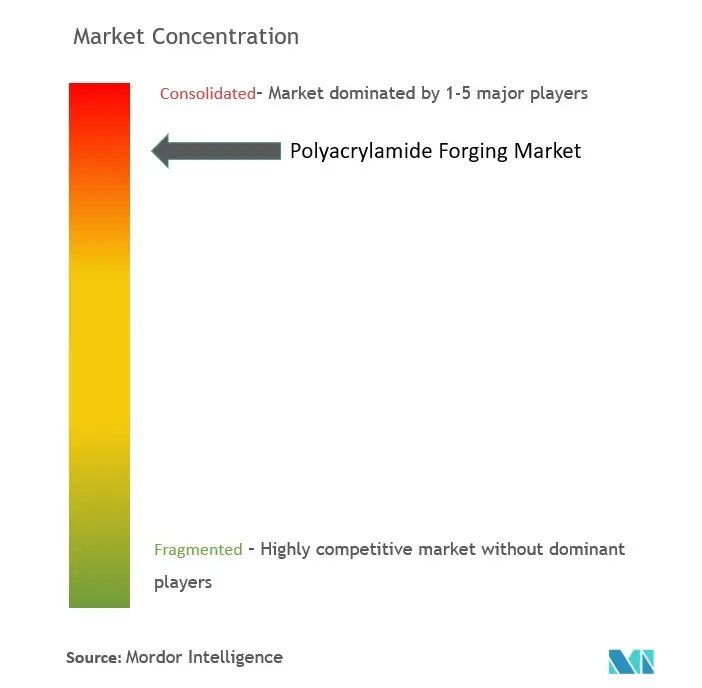
Polyacrylamide Market News
- February 2022: Kemira announced the initiation of full-scale production of its newly developed polymer-based (polyacrylamide) on biobased feedstock. With this production, Kemira further strengthened its position as the provider of sustainable chemistry solutions for water-intensive industries.
- January 2022: Solenis acquired 100% of the outstanding shares of SCL GmbH (“SCL”), which produces DMA3, a primary raw material for cationic polyacrylamide production. The aim of this acquisition was to help Solenis fulfill a strategic insourcing objective and support Solenis’ polyacrylamide strategic global growth plan.
Polyacrylamide Market Report - Table of Contents
1. INTRODUCTION
- 1.1 Study Assumptions
- 1.2 Scope of the Study
2. RESEARCH METHODOLOGY
3. EXECUTIVE SUMMARY
4. MARKET DYNAMICS
-
4.1 Market Drivers
- 4.1.1 Growing Utilization in the Oil and Gas Industry for Enhanced Oil Recovery
- 4.1.2 Increasing Demand for Polyacrylamide as a Flocculant in Water Treatment Industry
-
4.2 Market Restraints
- 4.2.1 Health Concerns Caused by Exposure to Acrylamide Monomer
- 4.3 Industry Value Chain Analysis
-
4.4 Industry Attractiveness - Porter's Five Forces Analysis
- 4.4.1 Bargaining Power of Suppliers
- 4.4.2 Bargaining Power of Consumers
- 4.4.3 Threat of New Entrants
- 4.4.4 Threat of Substitute Products and Services
- 4.4.5 Intensity of Competitive Rivalry
5. MARKET SEGMENTATION (Market Size in Volume)
-
5.1 By Physical Form
- 5.1.1 Powder
- 5.1.2 Liquid
- 5.1.3 Emulsion/Dispersions
-
5.2 By Application
- 5.2.1 Enhanced Oil Recovery
- 5.2.2 Flocculants for Water Treatment
- 5.2.3 Soil Conditioner
- 5.2.4 Binders and Stabilizers in Cosmetics
- 5.2.5 Other Applications
-
5.3 By End-user Industry
- 5.3.1 Water Treatment
- 5.3.2 Oil and Gas
- 5.3.3 Pulp and Paper
- 5.3.4 Mining
- 5.3.5 Other End-user Industries
-
5.4 By Geography
- 5.4.1 Asia-Pacific
- 5.4.1.1 China
- 5.4.1.2 India
- 5.4.1.3 Japan
- 5.4.1.4 South Korea
- 5.4.1.5 Rest of Asia-Pacific
- 5.4.2 North America
- 5.4.2.1 United States
- 5.4.2.2 Canada
- 5.4.2.3 Mexico
- 5.4.3 Europe
- 5.4.3.1 Germany
- 5.4.3.2 United Kingdom
- 5.4.3.3 France
- 5.4.3.4 Russia
- 5.4.3.5 Netherlands
- 5.4.3.6 Rest of Europe
- 5.4.4 South America
- 5.4.4.1 Brazil
- 5.4.4.2 Argentina
- 5.4.4.3 Rest of South America
- 5.4.5 Middle East and Africa
- 5.4.5.1 Saudi Arabia
- 5.4.5.2 South Africa
- 5.4.5.3 Rest of Middle East and Africa
6. COMPETITIVE LANDSCAPE
- 6.1 Mergers and Acquisitions, Joint Ventures, Collaborations, and Agreements
- 6.2 Market Ranking Analysis
- 6.3 Strategies Adopted by Leading Players
-
6.4 Company Profiles
- 6.4.1 AnHui JuCheng Fine Chemicals Co. Ltd
- 6.4.2 Anhui Tianrun Chemical Industry Co. Ltd
- 6.4.3 Ashland
- 6.4.4 BASF SE
- 6.4.5 Beijing Hengju Chemical Group Corporation
- 6.4.6 Beijing Xitao Technology Development Co. Ltd
- 6.4.7 CHINAFLOC
- 6.4.8 Envitech Chemical Specialities Pvt.Ltd
- 6.4.9 Kemira
- 6.4.10 Liaocheng Yongxing Environmental Protection Science&Technology Co. Ltd
- 6.4.11 Qingdao Oubo Chemical Co. Ltd
- 6.4.12 Shandong Tongli Chemical Co. Ltd
- 6.4.13 SNF Group
- 6.4.14 Solenis
- 6.4.15 Solvay
- 6.4.16 Yixing Cleanwater Chemicals Co. Ltd
- *List Not Exhaustive
7. MARKET OPPORTUNITIES AND FUTURE TRENDS
- 7.1 Emerging Applications of Polyacrylamide, such as its Use as a Biomaterial
- 7.2 Development of Bio-based Polyacrylamide
Polyacrylamide Industry Segmentation
Polyacrylamide is a water-soluble synthetic linear polymer made of acrylamide or the combination of acrylic acid and acrylamide.
The polyacrylamides market is segmented by physical form (powder, liquid, emulsion/dispersions), application (enhanced oil recovery, flocculants for water treatment, soil conditioner, binders and stabilizers in cosmetics, other applications) (food processing, etc.)), end-user industry (water treatment, oil and gas, pulp and paper, mining, other end-user industries (food, agriculture, cosmetics, etc.)) and geography (Asia-Pacific, North America, Europe, South America, and Middle East and Africa). The report offers market size and forecasts for the Polyacrylamide market in volume (kilotons) for all the above segments.
| By Physical Form | Powder | |
| Liquid | ||
| Emulsion/Dispersions | ||
| By Application | Enhanced Oil Recovery | |
| Flocculants for Water Treatment | ||
| Soil Conditioner | ||
| Binders and Stabilizers in Cosmetics | ||
| Other Applications | ||
| By End-user Industry | Water Treatment | |
| Oil and Gas | ||
| Pulp and Paper | ||
| Mining | ||
| Other End-user Industries | ||
| By Geography | Asia-Pacific | China |
| India | ||
| Japan | ||
| South Korea | ||
| Rest of Asia-Pacific | ||
| By Geography | North America | United States |
| Canada | ||
| Mexico | ||
| By Geography | Europe | Germany |
| United Kingdom | ||
| France | ||
| Russia | ||
| Netherlands | ||
| Rest of Europe | ||
| By Geography | South America | Brazil |
| Argentina | ||
| Rest of South America | ||
| By Geography | Middle East and Africa | Saudi Arabia |
| South Africa | ||
| Rest of Middle East and Africa |
Polyacrylamide Market Research Faqs
How big is the Polyacrylamide Market?
The Polyacrylamide Market size is expected to reach 2.17 million tons in 2024 and grow at a CAGR of 5.45% to reach 2.84 million tons by 2029.
What is the current Polyacrylamide Market size?
In 2024, the Polyacrylamide Market size is expected to reach 2.17 million tons.
Who are the key players in Polyacrylamide Market?
SNF Group, Kemira, BASF SE, Solenis and Solvay are the major companies operating in the Polyacrylamide Market.
Which is the fastest growing region in Polyacrylamide Market?
Asia Pacific is estimated to grow at the highest CAGR over the forecast period (2024-2029).
Which region has the biggest share in Polyacrylamide Market?
In 2024, the Asia Pacific accounts for the largest market share in Polyacrylamide Market.
What years does this Polyacrylamide Market cover, and what was the market size in 2023?
In 2023, the Polyacrylamide Market size was estimated at 2.06 million tons. The report covers the Polyacrylamide Market historical market size for years: 2019, 2020, 2021, 2022 and 2023. The report also forecasts the Polyacrylamide Market size for years: 2024, 2025, 2026, 2027, 2028 and 2029.
Polyacrylamide Industry Report
The global polyacrylamide market analysis covers various segments, including physical form, application, end-user industry, and geography. The market is segmented by physical form into powder, liquid, and emulsion/dispersions. Key applications include enhanced oil recovery, flocculants for water treatment, soil conditioner, binders and stabilizers in cosmetics, and other applications. The end-user industries encompass water treatment, oil and gas, pulp and paper, mining, and other sectors.
The industry analysis highlights the market size and forecasts for the polyacrylamide market, providing insights into the market share and revenue growth rate. This industry report offers a comprehensive market forecast outlook to help stakeholders understand the market trends and dynamics. The market review includes detailed industry information, industry statistics, and industry trends, which are crucial for making informed business decisions.
Market segmentation is thoroughly covered, offering a market overview and market outlook for different regions, including Asia-Pacific, North America, Europe, South America, and the Middle East and Africa. The market data and market predictions provide valuable insights into the future growth prospects of the polyacrylamide market. The report example and report PDF download offer a detailed market report, which includes market research and industry research conducted by leading research companies.
The market leaders and market growth are analyzed, providing an understanding of the competitive landscape. The industry outlook and market value are discussed, along with the price trend and market trends that influence the market dynamics. The industry reports and industry sales data support the market forecast, offering a clear picture of the market's future trajectory.
Overall, this comprehensive market analysis serves as a valuable resource for stakeholders, providing detailed insights into the polyacrylamide market's current state and future prospects.



